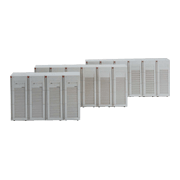This was the top-end model of the TP90 Series, first marketed in 1990 by Toshiba. It was targeted at the market for central computers in firms and organizations. The lower-end models of the TP90 Series (the TP90/20, 30, 40, 50 and 60) were first marketed in 1991, thus consolidating the overall lineup.
The TP90 Series was developed based on the central concept of "co-operated distributed processing" -- where each of the computers distributed in a network took a part of the work and co-operated with others. The main features of the TP90 Series were as follows:
- (1) Coverage of a wide performance range with a single architecture
- The TP90 Series was a set of higher-end versions of the V-7000 Series and employed a single architecture, but the series achieved performance 13 times that of the V-7030 (a low-end model of the V-7000 Series) by, for example, increasing CPU speed and providing symmetrical multi- processor support. The series also achieved a performance range of 50 times by using a cluster configuration called add-on enhancement,
- (2) Field upgrading
- Staged expansion of hardware, to accommodate greater work volume or increased database capacity, could be done at the user operations site. Up to a maximum of 3 CPUs could be incorporated in the same cabinet, as before, and up to a maximum 4 computer main units could be configured in a cluster (called "add-on enhancement" in the TP90 Series).
- (3) High reliability
- Duplicated configuration (automatic degradation of multi-CPUs, and duplication of disk drives and access buses)
Automatic degradation of main memory
Fail-over capability based on add-on enhancement
Integrity of databases and files using journal recovery - (4) Inherited network capabilities of V-7000
- Support for 130 communication protocols including OSI
Distributed processing using VNET - (5) Distributed OLTP
- The series provided support for "distributed OLTP" functionality which enabled transaction processing by dynamically linking screen processing on a client computer (optimally designed for the end user) with transaction processing on a server, without making the user aware of the network or database. Distributed OLTP allowed distributed database access using two-phase commit.
- (6) State-of-the-art semiconductor technology for high performance
- The CPU employed newly developed CMOS LSI with 3-layer aluminum wiring and an effective capacity of 100,000 gates.
The TP90/70 series was comprised of 3 models -- the TP90/73, TP90/75 and TP90/77. The main specifications were as follows:
| TP90/73 | TP90/75 | TP90/77 | ||
|---|---|---|---|---|
| Main unit | Number of CPUs | 1 | 2 | 3 |
| Add-on configuration | Possible | |||
| Memory | Capacity (MB) | 8-88 | ||
| Auxiliary memory units | FDD (Built-in) | Basic equipment: 1MB/3.5", Expansion: 1MB/5" | ||
| FDD (External) | Max. 64 drives (1MB 3.5"/5"/8") | |||
| Magnetic disk unit | 0.7GB-22.4GB | |||
| Magnetic tape unit | Open reel: Start-stop type, PE/GCR, 1600/6250bpi, 200ips Open reel: Streamer type, PE/GCR, 1600/6250bpi, 100ips Cartridge: Streamer type, GCR, 6250bpi, 120ips, 300MB |
|||
| Semiconductor file | Max. 256MB | |||
| Optic disk drive | 5GB, Max. 12 drives, with auto changer | |||
| "Integrated file" system | Connectable | |||
| Workstations | Display type | J-5010, J-5010L, J-5080, J-3100 Series, J-330 Series | ||
| OCR type | OCR-V595,V3050,V3030,V3010 | |||
| Maximum number connected | 512 | |||
| Input/Output equipment | Line printer | Line printer: 800LPM Kanji line printer:200LPM/360LPM Page printer:20PPM,1250LPM/3000LPM Kanji serial printer:100CPS/125CPS/135CPS |
||
| Image scanner | Transport type: 200dpi/400dpi, Max. A1 Static type: 400dpi/300dpi/240dpi, A4/A5/B5 |
|||
| Communication lines | Max. 192 | |||
| Other | Facsimile communication control etc. | |||


